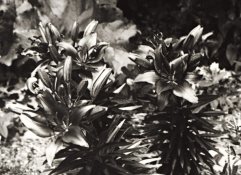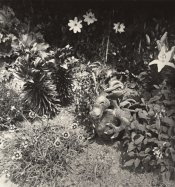Thanks Jim - 'total development' - sounds like the tag line on a Mercedes commercial! If I wanted to reproduce that effect would it be possible with modern materials/chemicals? Presumably negative density was purely down to exposure... I'd like to hear more about this. I read an article about Mortensen in which it is mentioned he put his negatives in the dev and then went off into town for the afternoon!
I still use this for those negatives which are exposed under very flat conditions. For instance - Death Valley in January, my favorite month to visit, is quite often heavily overcast. During these times the dunes may read as little as one stop difference between highlight and shadow. I develop these in a tray of well used D-23. Normal routine is to place in tray, agitate for 30 seconds, cover the tray with a black one and leave it for an hour. Agitate for another 30 seconds, and repeat the process. After about 3 hours I turn on the green safelight and look at the base of the negative to see if the highlights are present - if not I coninue the routine until they are. This produces beautiful negatives.
The secret as I know it is well used D-23. It is loaded with silver from previous use and over time some of this apparently replates in the highlight areas to produce additional density there.
I have never tried this with T-grain films,but I have used it with Tri-X, HP5+ and FP4+.
As for total development of average scenes, I have not done it in years. If you want to try it I suggest you mix up some D-23, develop several rolls or sheets of old film in it, or use it for your normal development for a time. After about 50 rolls or sheets of 4x5 it should have sufficient silver to work. D-23 keeps for inordinately long times if not contaminated. If you have,as I do, lots of out-dated film just open the package and expose it,then develop it to season your developer.
When I was learning in the 30's most photographers kept their film developers and replenished as needed to maintain activity. Use of developer in a one-shot method was just too expensive in those depression days. This re-use process provided workers with plenty of well used developer.
D-23 rarely needed replenishment, but could be with D-25. D-76, and Panthermic 777 and I'm sure many other developers were commonly replenished. These are the ones with which I worked at the time.
Try it - you may like it.
Also remember that most lenses of the time were not coated and thus there was more non-image light on the films than with current multi-coated lenses. This would contribute to the "glow", I think. That's why I still prefer lenses from before WWII. The trees in my photographs look like round trees, not flat cut outs pasted on the surface.














 But every time I use my Minolta A2, I am in awe. Just like when I see a print develop and make an image.
But every time I use my Minolta A2, I am in awe. Just like when I see a print develop and make an image. 